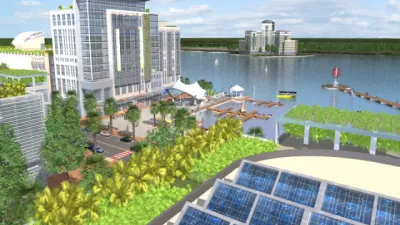Richard Register argues that we can do much more to redesign cities and city functions to reduce energy consumption, primarily by ceasing to plan for automobiles.
"The concepts behind the ecocity are fairly simple...[but] a major difficulty in moving toward ecocities is that cars have influenced urban design for 100 years. Many of us caught in this infrastructure find it extremely difficult to get around in anything but the car. The distances are just too great for bicycles, the densities just too low to allow efficient, affordable transit.
It's possible to build ecocities, and we must do so if we are ever to solve the looming triple crisis of climate change, declining biodiversity, and dwindling fossil fuel energy.
Cities are 'whole systems' and function something like living organisms. Their main organs are linked together, complementing each other's services for the benefit of the whole and relating the whole to its environment in a way that could be of reciprocal benefit to all organs and the whole organism. The city's organs include structures for transportation, living, working, education, shopping, recreation, manufacturing, and distribution.
The whole organism of the city we've been constructing for the last 150 years has been built on the basis of linking functions through ever-lengthening strands of connection.
[Eco-cities] are the wave of the future - if we are smart enough to get to that future in one piece."
FULL STORY: Cities Can Save the Earth

Study: Maui’s Plan to Convert Vacation Rentals to Long-Term Housing Could Cause Nearly $1 Billion Economic Loss
The plan would reduce visitor accommodation by 25,% resulting in 1,900 jobs lost.

North Texas Transit Leaders Tout Benefits of TOD for Growing Region
At a summit focused on transit-oriented development, policymakers discussed how North Texas’ expanded light rail system can serve as a tool for economic growth.

Why Should We Subsidize Public Transportation?
Many public transit agencies face financial stress due to rising costs, declining fare revenue, and declining subsidies. Transit advocates must provide a strong business case for increasing public transit funding.

How to Make US Trains Faster
Changes to boarding platforms and a switch to electric trains could improve U.S. passenger rail service without the added cost of high-speed rail.

Columbia’s Revitalized ‘Loop’ Is a Hub for Local Entrepreneurs
A focus on small businesses is helping a commercial corridor in Columbia, Missouri thrive.

Invasive Insect Threatens Minnesota’s Ash Forests
The Emerald Ash Borer is a rapidly spreading invasive pest threatening Minnesota’s ash trees, and homeowners are encouraged to plant diverse replacement species, avoid moving ash firewood, and monitor for signs of infestation.
Urban Design for Planners 1: Software Tools
This six-course series explores essential urban design concepts using open source software and equips planners with the tools they need to participate fully in the urban design process.
Planning for Universal Design
Learn the tools for implementing Universal Design in planning regulations.
City of Santa Clarita
Ascent Environmental
Institute for Housing and Urban Development Studies (IHS)
City of Grandview
Harvard GSD Executive Education
Toledo-Lucas County Plan Commissions
Salt Lake City
NYU Wagner Graduate School of Public Service



























